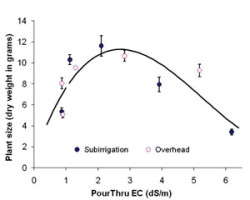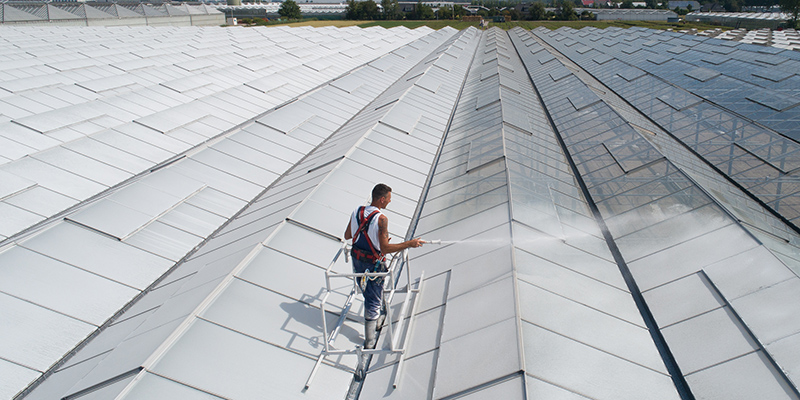Salts In Greenhouse Crops: Don’t Get Burned

Greenhouse bedding plants have been traditionally grown with high quality low-salt irrigation water because plants can be damaged when salts build up in the root zone. Because water is becoming a limiting factor in several parts of the United States and across the world, it is important to understand how floriculture crops respond to poor quality (i.e. high salt, non-potable water).
A better understanding of which plants are most sensitive to high salts can aid growers in crop selection and leaching practices. This article will describe where salts come from in greenhouse production, detection and symptoms of high salts, and how several bedding plant species responded to high salts in experiments at Cornell University.
Origins
Soluble salts are mineral nutrients and compounds that dissolve in water. In greenhouse production, they come from several sources. First, the irrigation water itself may be high salts. This may arise if the water source is located near mineral deposits, from contamination of the water source by road de-icing salts, or from the use of reclaimed municipal water.
A survey of Florida in 2005 notes that more than 230,000 acres of landscapes, golf courses and citrus orchards were being irrigated with reclaimed municipal water. A second cause of high salts comes from the substrate being used. Composts from animal manure can be particularly high in salts; potting mixes derived from these sources should be carefully monitored.
A further source of high salts comes from excess fertilizer use. When fertilizer is applied at rates much higher than the plant is using it in combination with no leaching, soluble salts can quickly build up to excessive levels. For example, in an experiment at Cornell we fertilized impatiens Super Elfin Mix with a commercial fertilizer (21-5-20) at rates of 50, 100, 200, 350 and 500 ppm nitrogen (Figure 1). When plants were sub-irrigated (i.e. no leaching) optimal growth was found with 100 to 200 ppm N. When plants were overhead watered and received 20 percent leaching daily, 200 to 350 ppm N was required for best growth. When salt concentration (as measured by PourThru EC) was greater than 3.0, plants were damaged by high salt levels. This occurred for plants receiving 500 ppm N in the overhead system and plants receiving 350 ppm N or greater in sub-irrigation.
Detection
The simplest way to detect and monitor salt levels is using a handheld electrical conductivity (EC) meter. EC is a measure of the total amount of salts in solution. EC meters rely on the property that an electrical current cannot pass through pure water, but the more dissolved salts are, the stronger the electrical current.
EC meters can be used to check salt levels of the water source, the irrigation water (to verify accuracy of fertilizer application) and to monitor root-zone salt levels. To collect a root-zone water sample, one of two methods are followed: in the 1:2 dilution method, a water sample is prepared by combining one part substrate and two parts water. The PourThru method involves adding a small amount of water to the top of a well-watered pot and measuring the leachate that comes from the bottom. For either test, a set of steps should be followed to ensure accuracy and consistency. Excellent information can be found from North Carolina State University at PourThruInfo.com.
A low root-zone EC (Table 1, scroll down) indicates that plants are receiving insufficient fertilizer (or are grown with a slow- or controlled-release fertilizer; their nutrients are not immediately soluble in water but released over time). A high root-zone EC indicates that your fertilizer rate is too high or you have high salts coming from one of the other sources mentioned already.
Symptoms
In the presence of high salts, osmotic effects are often the first symptoms that show up. That is, as root-zone salt levels rise, roots have a more difficult time extracting enough water for the plant. The osmotic or drought-stress symptoms can be subtle at first. For example, plants receiving high salts may be shorter and have smaller flowers than counterparts not exposed to high salts because there is limited water for cell expansion and elongation (Figure 3, scroll down). Plants exposed to high soluble salts may wilt even though the substrate is moist. In particular this can occur during the afternoon, when the sun is the strongest and plant water needs are the greatest. Root tips may become damaged to high salts, which provides an entry point to disease, and further limits the ability of the root system to extract enough water and nutrients.
Under a low to moderate salt stress, some plants may only show the osmotic symptoms already described. Attentive growers may notice plants are smaller than they should be but may not know the reason for this. As salt exposure continues, additional symptoms occur when plants accumulate toxic amounts of salts in their leaves. In this case, leaf tip or edge burn (marginal necrosis) are the most common symptoms. If the stress continues, the necrosis develops further inward so that entire regions of the leaf are affected.
In monocots, leaf burn usually begins on the tip of the leaf. Older leaves tend to be affected first as they have sat on the plant the longest and have had the most time to accumulate toxic amounts of salts. The symptoms described already are the response to general salt build up.
In some cases, specific ions are to blame. For example, fluoride added to municipal water sources at 1 ppm Fl can cause toxicity. Fl toxicity symptoms are leaf tip chlorosis, which develops into necrosis over time. Monocots, such as lilies and foliage plants, chlorophytum and dracaena, are particularly susceptible to fluoride damage. When substrate pH is low, iron or manganese are readily soluble and can build up to toxic levels in leaves. Symptoms include scattered bronze/chlorotic spots across lower leaves. Zonal and seed geraniums and marigolds are especially prone to iron/manganese toxicity. For this reason, their root-zone pH should be maintained at 6.0 to 6.6.
Sensitive Plants
Guidelines that allow us to classify which bedding plants are more sensitive to general high salt buildup would help growers make crop selection and management decisions based on their water supply. In order to come up with an up-to-date classification, we carried out a greenhouse experiment at Cornell to assess the impact of high salts to 14 common bedding plant species: coleus, Elatior begonia, euphorbia hybrid, French marigold, fuchsia, impatiens, pansy, petunia, salvia, snapdragon, verbena, vinca, Zinnia angustifolia and zonal geranium.
In this experiment, we artificially created high salt levels by using table salt (sodium chloride or NaCl) added to the irrigation water at five different treatment levels. This created a range of added salt levels from 0 to 1,840 ppm sodium and from 0 to 2,840 ppm chloride.
Plugs/liners of the species were transplanted into 4-inch pots containing a commercial peat-based substrate. After one week of establishment, these plants were irrigated daily with the salt treatments already described, plus a commercial fertilizer. Irrigation took place so as to cause a small fraction of water (about 5 percent) to leach at each irrigation event.
Within each treatment, five plants were randomly sampled each week to determine PourThru EC measurements. During the experiment, EC ranged from 4.0 mS/cm (control plants) to 14.5 mS/cm (highest salt treatment). EC was “normal” for control plants (based on the interpretation from Table 1), “very high” for plants receiving 460 ppm Na plus 710 ppm Cl, and “extreme” for plants receiving the three highest salt treatments.
After five weeks of salt treatments, we measured plant height and growth (dry weight). To be able to compare different species to each other we looked at salt effects based on relative plant size–that is size in comparison to untreated controls.
As might be expected, plant species respond differently to high salts. Petunia (Figure 2, scroll down), snapdragon, fuchsia and verbena were among the most tolerant species. As EC increased from 4.0 to 7.1, plant size of this group was reduced by less than 25 percent. Pansy and Zinnia angustifolia were among the most sensitive to salts. All were dead when exposed to the highest salt treatment for five weeks. Growth was reduced by about half at EC of 7.1, and leaf-edge burn symptoms were quite dramatic at this treatment. Other plants such as French marigold and vinca were somewhat tolerant of salts. At an EC of 7.1, growth was reduced by about one-third but no leaf symptoms such as edge burn were visible. This suggests a marketable but smaller crop could be produced with a “very high” EC.
Takeaways
Caution should be taken when interpreting our results. We studied growth during the transplant stage of well-established plugs/liners. Younger seedlings are often much more sensitive to high salts. Further, we looked at crops with a relatively quick finish time. The longer plants are exposed to high salts, the more likely it is that high salt damage can occur.









